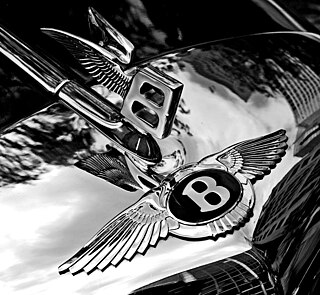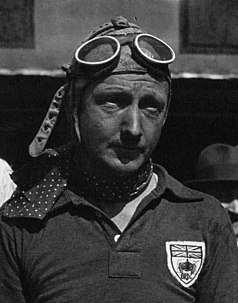Related Research Articles

Bentley Motors Limited is a British manufacturer and marketer of luxury cars and SUVs, and a subsidiary of the Volkswagen Group since 1998.

The Rover Company Limited was a British car manufacturing company that operated from its base in Solihull in Warwickshire. Its lasting reputation for quality and performance was such that its first postwar model reviewed by Road & Track in 1952 was pronounced finer than any but a Rolls-Royce. Rover also manufactured the Land Rover from 1948 onwards, which spawned the Range Rover in 1970, and went on to become its most successful and profitable product — with Land Rover eventually becoming a separate company and brand in its own right.

Walter Owen Bentley, MBE was an English engineer who founded Bentley Motors Limited in London. He was a motorcycle and car racer as young man. After making a name for himself as a designer of aircraft and automobile engines, Bentley established his own firm in 1919. He built the firm into one of the world's premier luxury and performance auto manufacturers, and led the marque to multiple victories at the 24 Hours of Le Mans. After selling his namesake company to Rolls-Royce Limited in 1931, he was employed as a designer for Lagonda, Aston Martin, and Armstrong Siddeley.

Sir Henry Ralph Stanley "Tim" Birkin, 3rd Baronet was a British racing driver, one of the "Bentley Boys" of the 1920s.

The Bentley 4½ Litre was a British car based on a rolling chassis built by Bentley Motors. Walter Owen Bentley replaced the Bentley 3 Litre with a more powerful car by increasing its engine displacement to 4.4 litres. A racing variant was known as the Blower Bentley.

The Bentley 6½ Litre and the high-performance Bentley Speed Six were rolling chassis in production from 1926 to 1930. The Speed Six, introduced in 1928, would become the most successful racing Bentley. Two Bentley Speed Sixes became known as the Blue Train Bentleys after their owner Woolf Barnato's involvement in the Blue Train Races of 1930.

The Bentley Boys were a group of wealthy British motorists who drove Bentley sports cars to victory in the 1920s and kept the marque's reputation for high performance alive. In 1925, as the marque foundered, Bentley Boy Woolf Barnato bought the company, leading to the creation of the famous supercharged Bentley Blower car.

Joel Woolf Barnato was a British financier and racing driver, one of the "Bentley Boys" of the 1920s. He achieved three consecutive wins out of three entries in the 24 Hours of Le Mans race.
The 1930 24 Hours of Le Mans was the 8th Grand Prix of Endurance that took place at the Circuit de la Sarthe on 21 and 22 June 1930. It saw the first appearance of a German car and the first entry from female drivers.

The 1929 24 Hours of Le Mans was the 7th Grand Prix of Endurance that took place at the Circuit de la Sarthe on 15 and 16 June 1929.
The 1928 24 Hours of Le Mans was the 6th Grand Prix of Endurance that took place at the Circuit de la Sarthe on 16 and 17 June 1928.
The 1926 24 Hours of Le Mans was the 4th Grand Prix of Endurance, and took place on 12 and 13 June 1926. It was the first Le Mans race where the winner's average speed was over 100 km/h (62 mph), and also the first to break the 24-hour distance record set by Selwyn Edge at Brooklands in 1907.
John Francis Duff was a Canadian racecar driver who won many races and has been inducted in the Canadian Motorsport Hall of Fame. He was one of only two Canadians who raced and won on England’s famous Brooklands Motor Course. The other, Kay Petre, is already an honoured member of the CMHF. Duff was the first Canadian to race in the legendary 24 Hours of Le Mans. To date, he is the only Canadian to win the overall classification at Le Mans.
The Calais-Mediterranée Express was a French luxury night express train which operated from 1886 to 2003. It gained international fame as the preferred train of wealthy and famous passengers between Calais and the French Riviera in the two decades before World War II. It was colloquially referred to as Le Train Bleu in French and the Blue Train in English because of its dark blue sleeping cars.
In Top Gear, a BBC motoring show, one of the show's regular features since 2002 is various forms of racing the presenters undertake, either against each other or against invited guests. The show has featured a number of epic races, where one of the presenters — Jeremy Clarkson, Richard Hammond, James May, and occasionally The Stig — drives a car in a race against the others in another form of transport. These races typically involve Clarkson driving the car while Hammond and May take the same journey by combinations of plane, train, or ferry. May has said that the races are planned to be as close as possible. Of the long distance races so far, the car has won the vast majority of the races, with the exceptions of the cross-London epic, in which the car was beaten by a bicycle, a boat on the Thames and public transport; Ferrari Daytona vs. Powerboat, in which the boat won; Shelby Mustang GT500 vs. High Speed Train, in which the train won; and the Arabian Peninsula race, in which the alternative 'money no-object' transportation options beat the Bugatti Chiron.
The Blue Train Races were a series of record-breaking attempts between automobiles and trains in the late 1920s and early 1930s. It saw a number of motorists and their own or sponsored automobiles race against the Le Train Bleu, a train that ran between Calais and the French Riviera. The rationale to beat the train was to compare the contemporary automotive performance with locomotive dominance; to showcase recent progress achieved by cars regarding reliability, durability, speed and comfort; to promote the cars, their marques and the adventurous persona of their drivers; and to establish automobiles as a viable and aspirational mode of transport for the individual traveller.

The Rover Light Six was a narrower lightweight short wheelbase variant of their Two-litre sports saloon produced from 1929 to 1930 by the Rover Company of Coventry. The following season it was sold with a 2½-litre 20 hp engine under the name Rover Light Twenty.

Bentley Blower No.1 is a racing car developed from the Bentley 4½ Litre by Sir Henry "Tim" Birkin to win the Le Mans twenty-four-hour race. The car was developed into its current form for racing at Brooklands.
The Rover Two-litre was a mid-size luxury open tourer, saloon or limousine produced from 1927 by the Rover Company of Coventry and available through to 1932. As usual the chassis was also available to coach builders.
References
- ↑ Graham Robson (1981). The Rover company (2 ed.). Patrick Stephens. ISBN 0-85059-543-6.
- ↑ Chris Brady & Andrew Lorenz (2005). End of the Road: The Real Story of the Downfall of Rover . Prentice Hall. ISBN 0-273-70653-5.
- ↑ Lewis, Robert (11 July 2003). "Five Million Rovers (And More)". Car Keys. Archived from the original on 22 July 2012. Retrieved 4 November 2008.CS1 maint: discouraged parameter (link)
- ↑ "Rover Report on their first 70 years". British Motor Heritage Centre. 26 July 1974. Retrieved 4 November 2008.
- ↑ Pickard, J. (16 November 2004). "Reserved and Refined British Saloon Cars: Official History of Rover and Timeline Milestones". Rover 1904-2004. Archived from the original on 2 May 2013. Retrieved 4 November 2008.CS1 maint: discouraged parameter (link)
- ↑ Melissen, Wouter (12 January 2004). "Bentley Speed Six 'Blue Train Special'". UltimateCarPage. Retrieved 4 November 2008.
- ↑ Burgess-Wise, David (1 January 2006). "The Slippery Shape of Power". Auto Aficionado. Archived from the original on 16 September 2008. Retrieved 4 November 2008.CS1 maint: discouraged parameter (link)